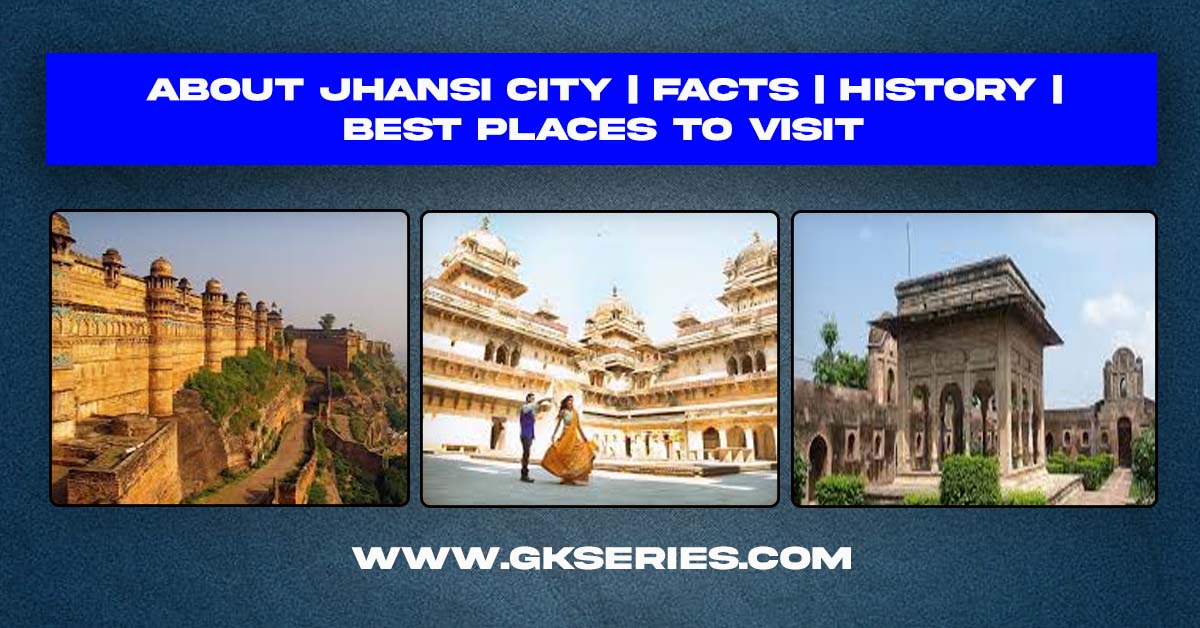
In this article, we provide comprehensive information about the geography, history, population, and top tourist destinations of Jhansi City. Jhansi, a historic city in the northern Indian state of Uttar Pradesh, is renowned for its rich heritage, vibrant culture, and significant role in India’s freedom struggle.
| About: | Jhansi district is one of the districts of Uttar Pradesh state in northern India. The city of Jhansi is the district and commissionary headquarters. The district is bordered on the north by Jalaun District, to the east by Hamirpur and Mahoba districts, to the south by Tikamgarh District of Madhya Pradesh state, to the southwest by Lalitpur District, which is joined to Jhansi District by a narrow corridor, and on the east by the Datia district of Madhya Pradesh. In 1891, Lalitpur District was added to Jhansi District, only to be again separated and made a separate district in 1974. Jhansi is a historic city located in the Indian state of Uttar Pradesh. It is a city in Bundelkhand, located on the banks of the Pahuj River in the extreme south of Uttar Pradesh. Jhansi is the administrative headquarters of Jhansi district and Jhansi division. Often regarded as the Gateway to Bundelkhand, Jhansi lies at an average elevation of 285 m (935 ft) between the rivers Pahuj and Betwa. It is about 415 km from New Delhi. The original walled city grew around its stone fort, which crowns a neighboring rock. The ancient name of the city was Balwantnagar until 1817-1854. Jhansi was the capital of the princely state of Jhansi which was ruled by Maratha rajas. In 1854, the British Governor-General annexed the state, rejected Damodar Rao’s claim to the throne, and Rani Lakshmibai reigned from 1857 to 1858. |
| History: | Jhansi city, situated between the rivers Pahunj and Betwa is a symbol of bravery, courage and self respect. It is said that in ancient times Jhansi was a part of the regions Chedi Rashtra, Jejak Bhukit, Jajhoti and Bundelkhand. Jhansi was a stronghold of the Chandela kings. Balwant Nagar was the name of this place. But in 11th. century Jhansi lost its importance. In 17th. century under Raja Bir Singh Deo of Orchha Jhansi again rose to prominence. Raja Bir Singh Deo had good relations with the mughal emperor Jehangir. In 1613 Raja Bir Singh Deo constructed the Jhansi fort. He died in 1627. After his death his son Jujhar Singh succeeded him. Maharaja Chattrasal Bundela of Panna was a good administrator and a brave warrior. In 1729 Mohammed Khan Bangash attacked Chattrasal. Peshwa Baji Rao (I ) helped Maharaja Chattrasal and defeated mughal army. As a mark of gratitude Maharaja Chattrasal offered a part of his state to Maratha Peshwa Baji Rao(I). Jhansi was also included in this part. In 1742 Naroshanker was made the subedar of Jhansi. During his tenure of 15 years he not only extended the Jhansi fort which was of strategic importance but also constructed some other buildings. The extended part of the fort is called Shankergarh. In 1757 Naroshanker was called back by the Peshwa. After him Madhav Govind Kakirde and then Babulal Kanahai were made the subedars of Jhansi. In 1766 Vishwas Rao Laxman was made the subedar of Jhansi. His period was from 1766 to 1769. After him Raghunath Rao (II) Newalkar was appointed the subedar of Jhansi. He was a very able administrator. He increased the revenue of the state. The MahaLakshmi Temple and the Raghunath Temple were built by him. For his own residence he constructed a beautiful building Rani Mahal in the city. In 1796 Raghunath Rao passed the subedari in favour of his brother ShivRao Hari. In 1803 a treaty was signed between East India company and Maratha. After the death of Shiv Rao his grand son Ramchandra Rao was made subedar of Jhansi. He was not a good administrator. Ramchandra Rao died in 1835. After his death Raghunath Rao (III) was made his successor. In 1838 Raghunath Rao (III) also died. The British rulers then accepted Gangadhar Rao as the Raja of Jhansi. Due to the inefficient administration during the period of Raghunath Rao (III) the financial position of Jhansi was very critical. Raja Gangadhar Rao was a very good administrator. He was very generous and full of sympathy. He gave very good administration to Jhansi. During his period the local population of Jhansi was very satisfied. |
| Economy: | Jhansi has a mixed economy, Jhansi’s economy is based on agriculture, industry, mining and tourism. |
| Geography: | Jhansi is located at 25.4333 N 78.5833 E. It is 284 metres (935 feet) above sea level on an average. Jhansi falls in the central Indian plateau, with rocky terrain and minerals below. The town has a natural slope in the northern direction, which rises from the southern border over the great Tarai plains of Uttar Pradesh. Among various crops cultivated here, wheat, pulses, peas, oilseeds, and citrus species are grown. Monsoons are heavily relied upon to provide irrigation facilities in the region. In this connection, the government is providing facilities to construct a network of canals under an ambitious canal project (the Rajghat canal) for irrigation purposes in Jhansi, Lalitpur and certain parts of Madhya Pradesh. The trade in agricultural products (including grain and oilseeds) is of economic significance. The city is also a brassware manufacturing centre. |
| Country : | India |
| State: | Uttar Pradesh |
| District: | Jhansi |
| Language: | Hindi |
| Population: | Metro- 547,638 (2011) |
| Literacy rate: | Average literacy rate of Jhansi city is 83.02 percent of which male and female literacy was 88.90 and 76.57 percent. |
| Major Attractions to Visit: | 1. Jhansi Fort. 2. Rani Mahal 3. Government Museum 4. Mahalakshmi Temple 5. Barua Sagar 6. St. Jude’s Shrine 7. Orchha (Nearby Attraction) 8. Parichha Dam |





